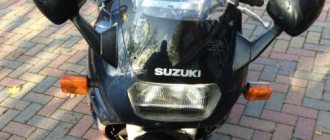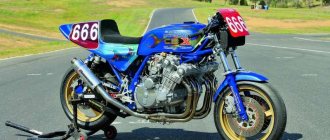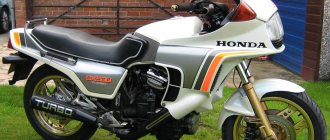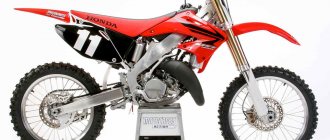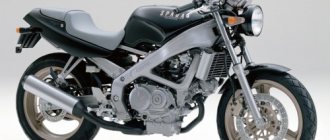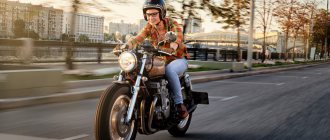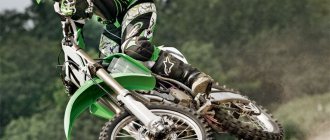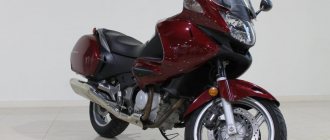For whom
Here are the main features of the model:
- classic exterior, typical of the brightest bikes in the class;
- very comfortable fit, but only if the rider has a suitable build;
- Driving is comfortable only at low speeds without sudden movements.
Honda CB 1000 is suitable for those who want to have a classic two-wheeled car for leisurely driving. Of course, this already quite old motorcycle is a desirable piece for collectors of the best Japanese technology.
Dimensions and weight
This is a fairly large bike with a very high center of gravity, and therefore requires some physical strength and height to control it. The seat height here is 810 mm, and the wheelbase dimensions are 1535 mm. The motorcycle is 2220 mm long, 785 mm wide, and 1130 mm high. Without fuel, the car weighs 235 kg, and with it - all 260 kg. The tank volume is quite large - 22 liters, however, fuel consumption per hundred kilometers is not small and in fact amounts to 7 liters.
Honda CB 1000
Information on the Honda CB 1000 motorcycle
Model of the classic road motorcycle Honda CB 1000 Super Four
first appeared in 1992 and was produced until 1997. The motorcycle is powered by a 4-cylinder in-line liquid-cooled engine with a capacity of almost 1000 cc. see and producing 98 hp. power (84 Nm of torque). Unlike sports “liters”, the Honda CB 1000 engine was derated, due to which it was possible to significantly increase torque at low and medium speeds, ensuring smooth, confident traction throughout the entire operating range.
Despite the rather short production period, the Honda CB 1000 model has won many fans around the world, thanks to which this motorcycle is in high demand to this day. In 1998, replaced by the Honda CB 1000
an updated version of the motorcycle arrives -
Honda CB 1300
.
It is also important to note that the Honda CB1000 model has nothing in common with the modern naked Honda CB1000R
, which has been produced since 2007. Despite the similarity of names, these are completely different motorcycles, built on different platforms and belonging to different classes.
The main competitors of the Honda CB 1000 in the class:
- Kawasaki ZRX 1100
/
Kawasaki ZRX 1200
/
Kawasaki Zephyr 1100 - Suzuki GSF 1200 Bandit
/
Suzuki GSX 1200 Inazuma - Yamaha XJR 1200
Brief history of the model
Throughout the entire production period, the Honda CB 1000 model remained virtually unchanged. Only in 1994 was a version with a semi-fairing introduced, which was later abandoned (in 1996).
Names and frame numbers of motorcycles depending on the year of manufacture:
- 1992-1993 – Honda CB1000FP, frame number: SC30-1000001.
- 1994-1995 – Honda CB1000FR, frame number: SC30-1100001.
- 1996-1997 – Honda CB1000FT, frame number: SC30-1200001.
Specifications
| Model | Honda CB 1000 Super Four (Big-1) |
| Motorcycle type | road (classic) |
| Year of issue | 1992-1997 |
| Frame | steel duplex |
| engine's type | 4-cylinder, 4-stroke |
| Working volume | 998 cc cm. |
| Bore/Stroke | 77 mm x 53.6 mm |
| Compression ratio | 10,0:1 |
| Cooling | Liquid |
| Number of valves per cylinder | DOHC, 4 valves per cylinder |
| Fuel supply system | 4 Keihin carburetors, 34 mm |
| Ignition type | electronic |
| Maximum power | 98 hp at 8500 rpm |
| Maximum torque | 84 Nm at 6000 rpm |
| Transmission | 5-speed |
| type of drive | chain |
| Front tire size | 120/70-18 |
| Rear tire size | 170/60-18 |
| Front brakes | 2 discs 310 mm, 4-piston calipers |
| Rear brakes | single disc 276 mm, 1-piston caliper |
| Front suspension | 43 mm telescopic fork |
| Rear suspension | double shock absorber (preload adjustment) |
| Length | 2340 mm |
| Width | 785 mm |
| Height | 1130 mm |
| Wheelbase | 1540 mm |
| Seat height | 810 mm |
| Acceleration to 100 km/h | 4.0 sec |
| Maximum speed | 226 km/h |
| Gas tank capacity | 22 l |
| Motorcycle weight (dry) | 236 kg |
Fuel consumption
Average fuel consumption on a Honda CB 1000 is approximately 6-7 liters per 100 km. The exact value depends on your riding style.
The price for a Honda CB 1000 Super Four (Big-1) in good technical condition, without mileage in the Russian Federation, is in the range of $3000-3500. The price for models with mileage in the Russian Federation starts from 115,000 rubles.
Chassis and brakes
The CB 1000 has a duplex frame made of steel. The abundance of metal in the exterior immediately catches the eye. Although this is a classic motorcycle, the wheels are alloy. The steering wheel is very comfortable and has traditional dimensions for this class.
As for the suspension, at the rear there is a pendulum version with a double shock absorber, at the front there is a 43 mm telescopic fork. This is a completely natural solution for the class.
The rear brake is a 276 mm disc with a single-piston caliper, and the front is a pair of 310 mm discs with four-piston calipers. It is these components of the bike’s chassis that react particularly sharply to sudden changes in speed and other sporting habits of the rider.
Motorcycle CB 1000SF-T2 1994 (Japan): technical specifications, photos, videos
Individual selection and sale of motorcycles from auctions in Japan and America
We work all over Russia
Honda motorcycle catalog
| HONDA CB1000 in the catalog | All HONDA models |
| Model: | Type: | Year of release: | Horsepower: | Volume: |
| CB1000 | roadster | 1994-2007 | 98 | 998 |
Riding the Elevator Test
text from MotoReview: Denis Davydov
Honda CB1000: 998 cm3, 98 hp, 195 km/h, $4200-5300, 1994
The device is of Japanese origin, which is natural for a second-hand store.
From the very first kilometers I began to associate a motorcycle with a high-speed elevator, which was put on the spot by some crazy designer. Hyper acceleration that makes the bike rear up? Convulsively clicking gears just to stay at peak power? No, this is not about the CB1000. Just turn the throttle and a pleasant heaviness spreads throughout the body. I was especially pleased with the second gear, which easily made it possible to start from a stop and accelerate well beyond a hundred.
Intensive use of the bike quickly revealed one unpleasant feature in its ergonomics: the complete absence of a fuel quantity control system. There is no level indicator, or even a control lamp. This would be forgivable in an enduro bike, which doesn't often find itself in a stable horizontal position anyway. But not for a road bike. Of course, there is always insurance in the form of a reserve, but this also has its difficulties. The fact is that the valve for switching to reserve, located on the left side, is closed by the driver’s thigh while driving.
Winter has flown by in anticipation of the new season, and now it has finally arrived. It's time to prepare the motorcycle for long journeys. This is where the time has come to stand in awe of the design genius of Honda engineers. Of course, I am not a mechanic, but, nevertheless, I will take the liberty to say that the CB1000 is one of the most convenient motorcycles to maintain. To replace the air filter, you don't have to touch the gas tank; the filter box is located under the decorative side panel, which is held in place by only one bolt. To replace the shock absorber fluid, special drain holes are provided in the front fork. Agree that unscrewing two drain bolts is much easier than dismantling the fork stays and taking a long time to shake out the remaining old oil from them. And finally, the gas tank mounting mechanism! In order to get to the thermostat or replace spark plugs, it is absolutely not necessary to remove it. The design is reminiscent of a car hood. The small locking bolts are unscrewed, the tank moves back, and its front part rises up. A special support is provided to hold the tank in a raised position. In general, I would like to say a big thank you to Japanese engineers for their comprehensive care for the consumer.
But it wasn't without problems. Moreover, where they were not expected. The first one occurred when replacing spark plugs. The diameter of the spark plug channel turned out to be too small for a standard 18 spark plug wrench made by Kingtony. I had to look for a thin-walled key made from a tube. The second problem is much more serious, and is still awaiting its solution. We are talking about the leading sprocket. The old one had sufficient output, and I decided to replace it. When I tried to install a new sprocket, which I ordered from the European Honda catalog, I discovered that it did not fit the chain. A closer inspection showed that the purchased sprocket was designed to use a 530 type chain, while the type installed on the motorcycle was 525. Further communication with the manager of a motorcycle parts store revealed a disappointing truth: European-assembled motorcycles use 530 type chains, or 520 type chains as an alternative. The Japanese origin of the bike made itself felt. As a result, I left everything in the same place and began to mentally prepare for the purchase of a new chain and driven sprocket.
Continuing the description of the differences between the Japanese and European modifications of the CB1000, I will note the absence of a mini-back behind the passenger seat for the “Japanese”. It would seem like nothing. But this trifle did not allow me to order and install a hard case, since the design of cases for the CB1000 involves the use of attachment points for this very backrest.
I would like to end the “screwdriver” topic with the most pleasant and least labor-intensive episode. At some point, a technically insignificant, but aesthetically important little detail began to irritate me: the appearance of the standard sound signals located under the headlight. Black painted wheels surrounded by shiny metal parts looked more than unpresentable. I installed a pair of higher power chrome Nikko Horns and it was not only nice, but useful. The increase in sound intensity had the most positive effect on the speed of the fathers of families’ rebound from the trajectory of movement.
The final formation of my opinion about the motorcycle was facilitated by a raid in Europe this summer. And the most important advantage for me was its reliability. One of my friends' motorcycles had oil-eating problems, and another suffered from engine overcooling. My device has not let me down in any way. I think that the key to this reliability is the simplicity and refinement of the design, as well as the undeniable quality of Honda products, enhanced by Japanese assembly. There is no need to talk about the CB1000 motor at all; the nickname “indestructible” has long been attached to it. On the way, I had the opportunity to compare the driving performance of my device and the Yamaha TDM850. Of course, any expert will say that the TDM has much better handling, because its design is more progressive. But personally, I didn’t like this flexibility. On the other hand, the CB1000 holds its course well due to its mass (dry weight - 235 kg) and is not so susceptible to crosswind impacts due to the lack of plastic lining. And the fact that you have to put a little pressure on it to enter a turn is even nice. In general, it is clear which side my sympathies are on.
Fuel consumption: 6.5 liters per 100 km for the urban cycle. Naturally, as the speed increases, the consumption increases and at a speed of 150 km/h it reaches 10 liters. On the polished European roads it is convenient to test the motorcycle in various speed modes. The speed of 140 km/h is reached in one breath. In the range of 140-180 km/h, the acceleration dynamics remain quite vigorous, but with a further increase in speed they disappear. It is claimed that vehicles imported from Japan have speed limiters that start working when they reach 180 km/h, but I can neither confirm nor deny this opinion. I didn’t feel any specific changes after overcoming the threshold. However, the speedometer is indeed calibrated to this magic number. The maximum speed that I managed to achieve was approximately 195 km/h (the speedometer needle was already in the black zone). It may not be the limit, but by this point the vibrations on the steering wheel and the impacts of the air flow become so strong that everything becomes blurry in your eyes. Prudence prevails: this motorcycle is not designed for such speeds.
It's designed for a little bit of everything: driving quickly through a crowded city or going on a long journey, and, if necessary, leaving that road and making your way along a forest path. It's a compromise, but a compromise with a capital C.
